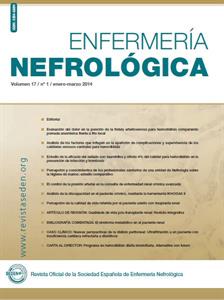Contenido del artículo principal
Resumen
Nos propusimos valorar los resultados obtenidos, tras la formación e intervenciones de enfermería realizadas para mejorar la presión arterial, en pacientes con enfermedad renal crónica avanzada.
Material y Método
Se realizó un estudio descriptivo retrospectivo, de 6 meses de duración. Se estudiaron todos los pacientes incidentes
en la consulta de enfermedad renal crónica avanzada. Se recogieron los datos relacionados con la enfermedad renal crónica avanzada y su evolución, en la consulta inicial, a los tres y seis meses.
Resultados
La muestra la formaron un total de 148 pacientes, de los cuales el 60,8% eran hombres. La edad media fue
68,7 ± 14,8 años.
Evaluamos los cambios en las constantes vitales relacionadas con la presión arterial a lo largo del estudio,
obteniendo diferencias signifi cativas para la presión arterial sistólica (p<0,001), la presión arterial diastólica (p<0,001) y para la presión arterial media (p<0,001), no siendo así para la frecuencia cardiaca (p=0,307).
El número de hipotensores disminuyó a lo largo del estudio sin significación estadística. Existió una diferencia significativa en el peso de los pacientes pasando de 80,1±16,7 kg. a 77,6±16,1 kg. al fi nal del seguimiento
(p<0,001). La presencia de edemas varió de un 26,1% a un 18,8% al concluir el estudio (p=0,052).
Analizamos el sodio en orina (p=0,665) y observamos que no hubo diferencias signifi cativas. Sí encontramos
cambios signifi cativos en el hábito tabáquico (p=0,004) pero no en el consumo de alcohol (p=0,5).
Conclusiones
Las actividades de enfermería han conseguido mejorar el control de la presión arterial, a los pacientes incidentes
en la consulta enfermedad renal crónica avanzada. Estas intervenciones deben ser una constante en el tratamiento
del paciente hipertenso con enfermedad renal crónica avanzada.
Material y Método
Se realizó un estudio descriptivo retrospectivo, de 6 meses de duración. Se estudiaron todos los pacientes incidentes
en la consulta de enfermedad renal crónica avanzada. Se recogieron los datos relacionados con la enfermedad renal crónica avanzada y su evolución, en la consulta inicial, a los tres y seis meses.
Resultados
La muestra la formaron un total de 148 pacientes, de los cuales el 60,8% eran hombres. La edad media fue
68,7 ± 14,8 años.
Evaluamos los cambios en las constantes vitales relacionadas con la presión arterial a lo largo del estudio,
obteniendo diferencias signifi cativas para la presión arterial sistólica (p<0,001), la presión arterial diastólica (p<0,001) y para la presión arterial media (p<0,001), no siendo así para la frecuencia cardiaca (p=0,307).
El número de hipotensores disminuyó a lo largo del estudio sin significación estadística. Existió una diferencia significativa en el peso de los pacientes pasando de 80,1±16,7 kg. a 77,6±16,1 kg. al fi nal del seguimiento
(p<0,001). La presencia de edemas varió de un 26,1% a un 18,8% al concluir el estudio (p=0,052).
Analizamos el sodio en orina (p=0,665) y observamos que no hubo diferencias signifi cativas. Sí encontramos
cambios signifi cativos en el hábito tabáquico (p=0,004) pero no en el consumo de alcohol (p=0,5).
Conclusiones
Las actividades de enfermería han conseguido mejorar el control de la presión arterial, a los pacientes incidentes
en la consulta enfermedad renal crónica avanzada. Estas intervenciones deben ser una constante en el tratamiento
del paciente hipertenso con enfermedad renal crónica avanzada.
Palabras clave
enfermedad renal crónica avanzada; presión arterial; consulta erca.
Detalles del artículo
Licencia
Aviso de derechos de autor/a
© Los autores ceden de forma no exclusiva los derechos de explotación de los trabajos publicados y consiente en que su uso y distribución se realice con la Licencia Creative Commons Atribución - No comercial 4.0 Internacional (CC BY-NC 4.0). Puede consultar desde aquí la versión informativa y el texto legal de la licencia. Esta circunstancia ha de hacerse constar expresamente de esta forma cuando sea necesario.
Cómo citar
1.
Cirera Segura F, Pérez Baena Álvaro, Sánchez Flores N, Martín Espejo JL. El control de la presión arterial en la consulta de enfermedad renal crónica. Enferm Nefrol [Internet]. 2014 [consultado 13 Dic 2025];17(1):[aprox. 4 p.]. Disponible en: https://www.enfermerianefrologica.com/revista/article/view/4230




